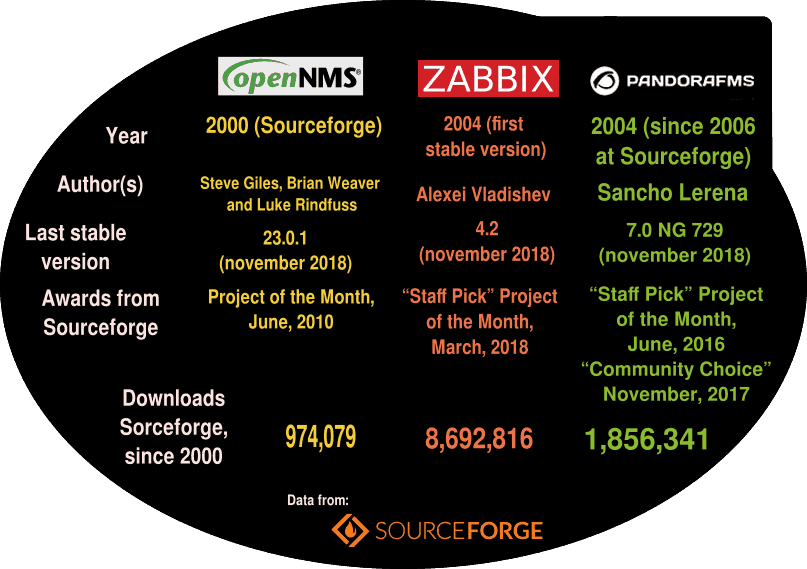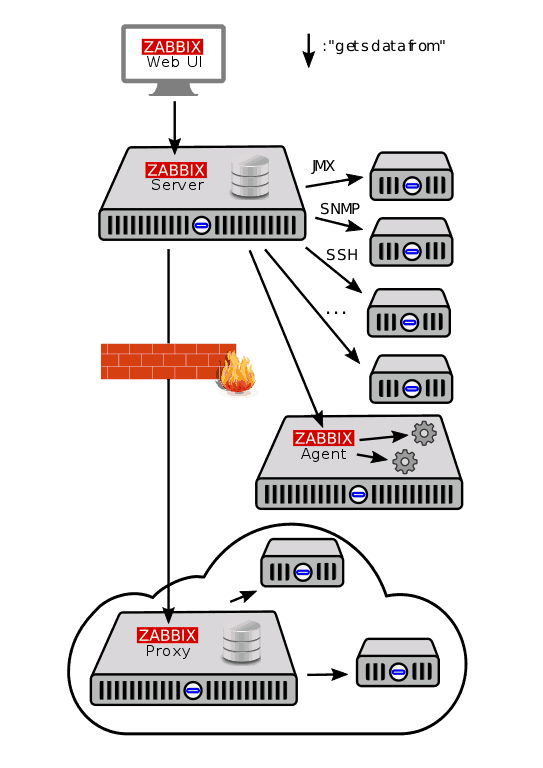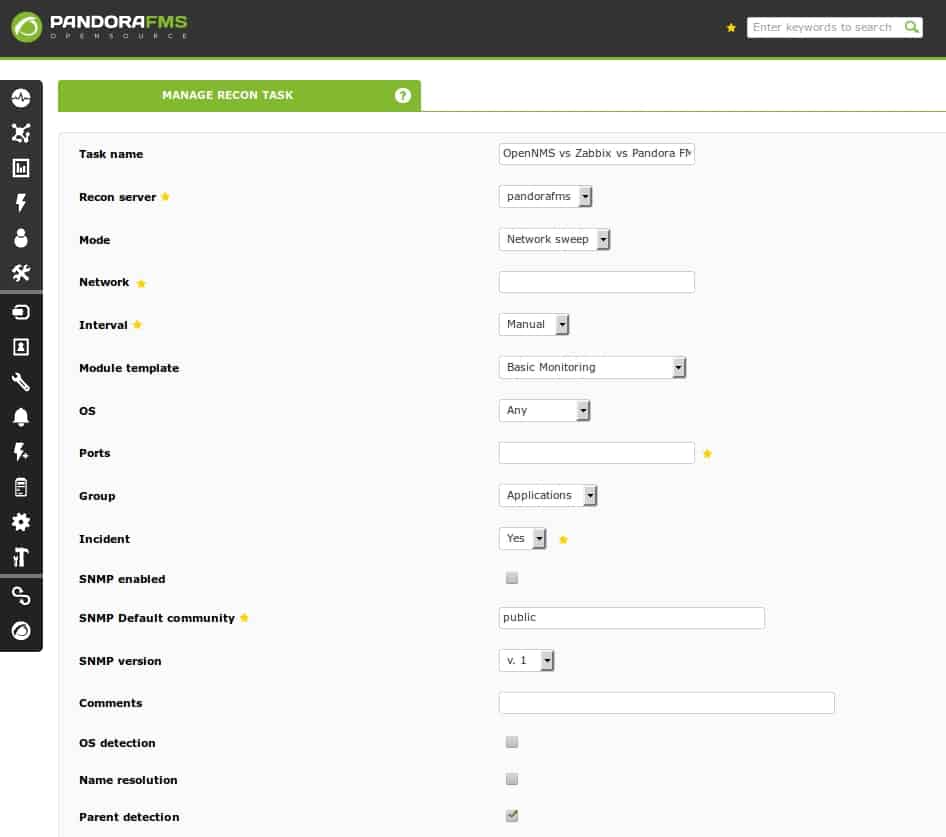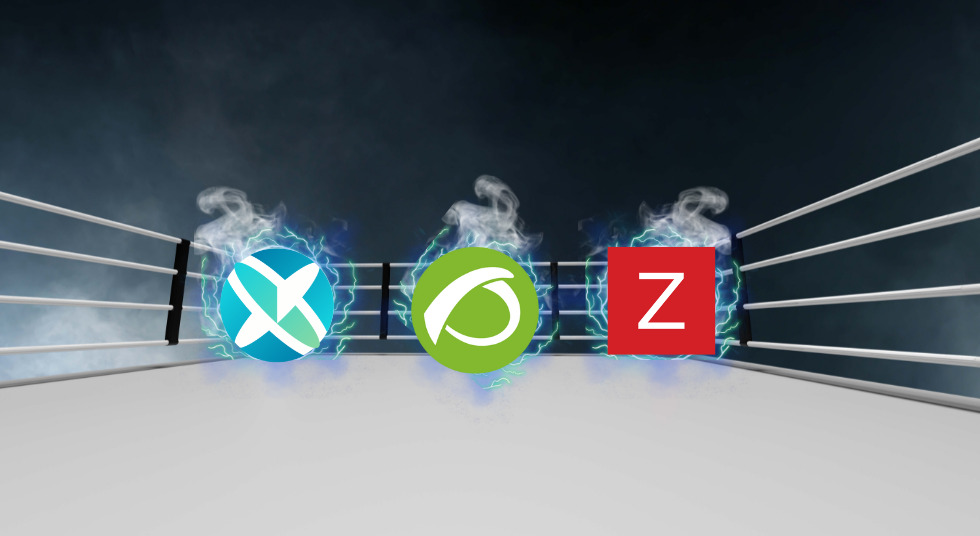OpenNMS vs Zabbix vs Pandora FMS. Here we go!
Today we bring you a comparison: OpenNMS vs Zabbix vs Pandora FMS. Three titans of open-source software, without a doubt. We will see its main features and we will talk about the business model of each company -free does not necessarily mean for free- and we will summarize with graphic information.
Three monitoring solutions that are rather projects: these are software made by companies that share their code with everyone and that can be used -and modified- by anyone.
OpenNMS vs Zabbix vs Pandora FMS
Let’s lay the cards on the table: both OpenNMS and Zabbix are strongly oriented to network monitoring, and of course Pandora FMS performs such tasks. However, Pandora FMS has a global vision, since it is an award-winning flexible network management platform that helps network operators, server administrators and engineers today to monitor service availability and times of response.
All of them are original developments and they have not undergone public bifurcations, and they’ve been around roughly the same time in the market. OpenNMS since 2000, Zabbix and Pandora FMS since 2004 (the release of the first public and stable versions).
Sourceforge.net
In the popular repository Sourceforge our three analyzed software occupy their places, with Zabbix in the first place of downloads with more than eight million downloads, Pandora FMS close to two million and OpenNMS does not reach that amount. This is quite interesting since it is the longest-running software. One of the reasons is that its documentation is tremendously technical, you can tell by just reading the frequently asked questions on its website. The learning curve is difficult, while Pandora FMS has extensive documentation that draws on the Enterprise version and, of course, the community around it. Zabbix is not easy to install either. Although we will fix the repositories directed to the respective software houses and use the commands apt-get or yum (Debian / related and CentOS / related, respectively) in Zabbix we will have to start the schemas of the databases (They must have different names if the Zabbix Server and the Zabbix Proxy are installed on the same machine, in addition to the system users. We must also configure many of the PHP values before proceeding to start the services. We do not say that Pandora FMS has a fully automated installation, but it is close to this. Once we have accessed the Pandora FMS console, we will receive step-by-step instructions for each parameter that is still to be configured, (see even the installation in a Raspberry). For the case of OpenNMS we noticed that it also has an installer that simplifies the repositories directly to your website, then we go to accept the license to use Java and the creation of system users in the base of PostgreSQL data.

OpenNMS vs Zabbix vs Pandora FMS
The help and documentation of OpenNMS is in English only; which is not surprising, since its headquarters is in the United States and its strong market is that country. The Wiki page of Pandora FMS is in English, Japanese, Spanish, Estonian and French, and is only surpassed by the Zabbix documentation in English, French, Japanese, Polish, Portuguese, Russian, Turkish and Chinese. We want to mention that the user interface in the web console is a different thing, it is what we see every day in our work and here Pandora FMS stands out with the following languages: English, Spanish, Japanese, Russian, Chinese, German, French, Portuguese, Polish, Italian and Arabic. While the community of OpenNMS has deteriorated over time, with Zabbix there is a large community, almost all settled in North America, and in the case of Pandora FMS its community is dispersed around in many countries of several continents.

OpenNMS vs Zabbix vs Pandora FMS
Customer Market
Yes, we told you that we would briefly talk about the business model of each solution. In the case of OpenNMS they have clearly expressed that they focus on clients that wish to migrate from Tivoli® and Openview® ; On the other hand Zabbix is massive and has no preference, everything is a monolithic market. In Pandora FMS there is a certain taste for “rescuing” the users from Nagios but, the community version is intended for customers with up to 100 devices: for more than that amount, Enterprise version is available, that not only includes code but also logistic support.
Architecture
OpenNMS has a solid structure because, it is written in Java “language” (and everything that implies, to the web server Jetty); both Zabbix and Pandora FMS have a complex and modular architecture.

Zabbix Architecture
(Wikipedia https://commons.wikimedia.org/wiki/File:Zabbix_architecture.svg)
Device recognition
Once installed and running, the Zabbix server allows us the option to use some of the “templates” for several types of common servers (although it makes use of the famous regular expressions, which have additional work to “decipher”) or we can configure for the agents to self-register. For Pandora FMS we can use the Reconnaissance Server, a “script” of Basic Monitoring that will be responsible for the various necessary values of the devices found (IP address, operating system and / or SNMP, etc.)

“Recon Server” of Pandora FMS
For the three scenarios we will use Software Agents, small programs that from each computer are responsible for collecting the metrics and then send them to the respective server. The three solutions have agents for Linux, Unix, Windows®, MacOS® and others.
Added
Pandora FMS has the built-in remote access added by eHorus and manages the network protocol created by Cisco and known as Netflow; in OpenNMS make an open invitation to the community to integrate this protocol and in Zabbix we only observe comments from users on this topic. The three alternatives, OpenNMS versus Zabbix versus PandoraFMS, have add-ons developed by the respective communities, in addition to the paid business add-ons.
User interface
For OpenNMS is difficult, we observe an old graphic style of the beginning of the century. We have to highlight Zabbix on the “dashboards” and Pandora FMS has the same feature but not as eye-catching. Where Pandora FMS really stands out is in the graphics system, exportable in PDF and oriented for delivery to the top management or executives of the company.
Pandora FMS
Now that we have seen the comparative OpenNMS vs Zabbix vs Pandora FMS, and if your company still uses OpenNMS or Zabbix, you can get to know Pandora FMS as an alternative. You can click on this website to find out our OpenSource version: https://pandorafms.com/
And remember that if you have to monitor more than 100 devices you can also enjoy a 30 days FREE DEMO of Pandora FMS Enterprise. Get it here.
Do you want to know more about Pandora FMS?
Pandora FMS’s editorial team is made up of a group of writers and IT professionals with one thing in common: their passion for computer system monitoring. Pandora FMS’s editorial team is made up of a group of writers and IT professionals with one thing in common: their passion for computer system monitoring.


















